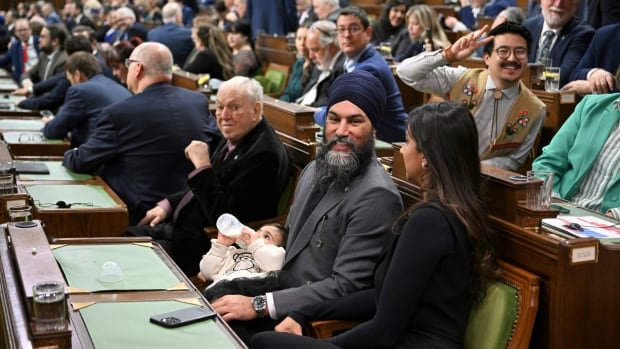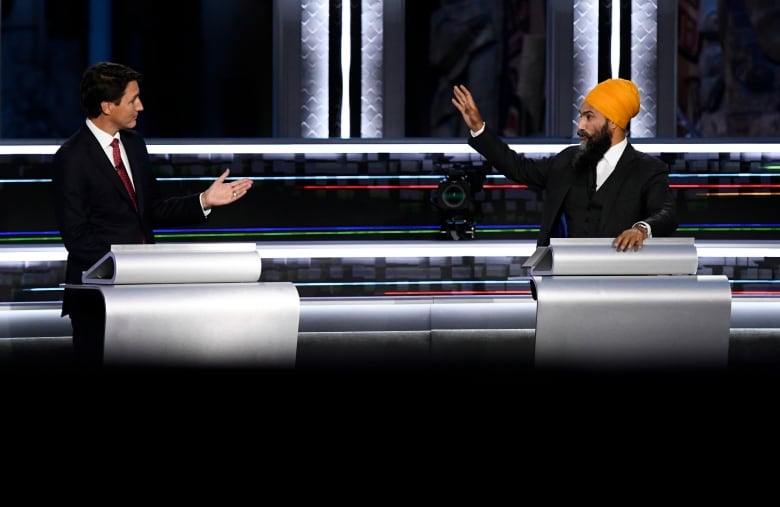
For all anyone knows, this might be as good as it gets for Jagmeet Singh’s NDP. But would that be so bad?
The NDP is certainly in a celebratory mood. On Wednesday, the day after the federal budget, the party’s MPs staged a mini-pep rally for the television cameras to celebrate their influence on the document. Singh announced an eight-city “post-budget tour” to “talk to Canadians about how the NDP delivered results that put money back in their pockets.”
Some of the victories New Democrats are claiming for themselves are at least open to debate. Left to its own devices, the Liberal government might have ended up boosting the GST credit last fall anyway — and might have done so again in this year’s budget. (Still, the decision to now promote the extra payment as a “grocery rebate” feels like a nod to the complaints New Democrats have focused on major grocers).
The Liberals also might not have needed the NDP’s help to decide to apply labour standards to the new round of investment tax credits for clean tech.
But a new dental care program for low-income Canadians is an indisputable NDP win. While it’s a Liberal government that will actually implement the program — Prime Minister Justin Trudeau was in New Brunswick on Friday to tout “affordable dental care” — dental care was not a feature of the Liberal platform in either the 2019 or 2021 federal elections.
Maybe some future Liberal government would have turned its mind to the idea after dealing with other priorities. Trudeau’s Liberals mentioned it as a notion “worth exploring” in their 2019 throne speech.
But it’s happening now because the Liberals and New Democrats were willing to sign a supply-and-confidence agreement and the NDP needed something to show for it.

When the budget was released on Tuesday, reporters focused on a new projection of how much a federal dental program will cost. Once it’s fully up and running, the program is expected to require annual funding of $4.4 billion — the federal government previously predicted an annual cost of $1.7 billion.
Less attention was paid to how many Canadians are expected to use the program. The federal government now estimates nine million people will use the dental care program once it’s fully operational.
That is a significant increase over previous estimates. A projection released by the parliamentary budget officer last year assumed that 5.9 million people would use the program. Two years earlier, the PBO estimated that 6.3 million people would benefit in 2025.
Even if the latest official projection turns out to be overly bullish, it seems safe to assume some significant number of Canadians who currently don’t have sufficient insurance coverage could be able to access dental care without incurring costs they can’t afford.
That would not be a small thing.
The government says that an interim measure introduced last year — the Canada Dental Benefit — has helped the families of more than 240,000 children. That benefit suffers from a flawed design and process. And it’s fair to wonder how well the full program — which will be administered by Health Canada with “support from a third-party benefits administrator” — will function. The details of eligible coverage won’t come until later this year.
But if the government can get the program up and running before the next election, it might be very hard for a future government to take it away.
A victory, regardless of result
The supply-and-confidence agreement between the Liberals and NDP, now a year old, is something of a live experiment. Similar deals have been done at the provincial level, but this is the first time such an arrangement has been tried within the hothouse atmosphere of Parliament Hill.
Everyone is still getting used to an unfamiliar reality. Reporters constantly ask Singh what it would take for him to walk away from the deal, while Singh still lacks a nuanced explanation for why he isn’t willing to defeat a government he regularly condemns in the harshest terms.
There is a risk, too, that the success or failure of the deal will be judged merely by the result of the next election. If the NDP is crushed in the next election and the Liberals regain a majority, the confidence-and-supply agreement will be blamed. If the New Democrats increase their seat count, the confidence-and-supply agreement will be credited.
Winning seats in the House of Commons is obviously the overarching goal of every political party. But the point of winning seats is the power those seats give you to actually do stuff. Doing stuff is the actual point of politics — and the confidence-and-supply agreement gives the NDP a hand in getting stuff done.
If the NDP hopes to win more seats in the next election, it probably needs to show that a vote for the NDP is not wasted. But even if the NDP doesn’t win a single additional seat in the next election — even if its caucus is completely wiped out — it would still be a lasting and real victory for Jagmeet Singh and his caucus if they can come away from their time in Parliament with a national dental care program.
Such things can be easy to overlook. Unless, of course, you’re someone who ends up suddenly being able to afford to go to the dentist.